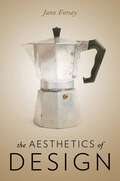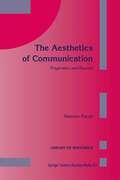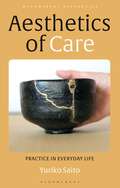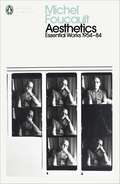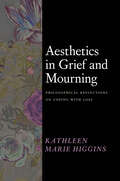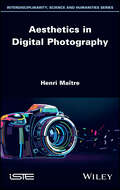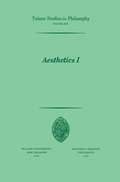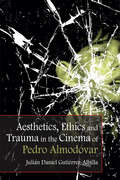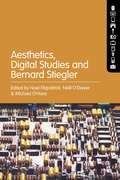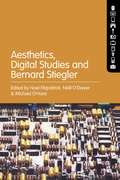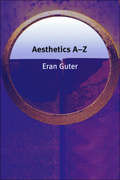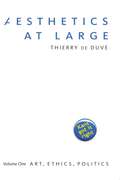- Table View
- List View
The Aesthetics of Education: Theatre, Curiosity, and Politics in the Work of Jacques Ranciere and Paulo Freire
by Tyson E. LewisThis innovative book examines the aesthetic event of education. Extending beyond the pedagogy of art or art appreciation, Tyson E. Lewis takes a much broader view of aesthetics and argues that teaching and learning are themselves aesthetic performances. As Jacques Ranciere has recently argued, there is an inherent connection between aesthetics and politics, both of which disrupt conventional distributions of who can speak and think. Here, Lewis extends Ranciere's general thesis to examine how there is not only an aesthetics of politics but also an aesthetics of education. In particular, Lewis' analysis focuses on several questions: What are the possibilities and limitations of building analogies between teachers and artists, education and specific aesthetic forms? What is the relationship between democracy and aesthetic sensibilities? Lewis examines these questions by juxtaposing Ranciere's work on universal teaching, democracy, and aesthetics with Paulo Freire's work on critical pedagogy, freedom, and literacy. The result is an extension and problematization of Ranciere's project as well as a new appreciation for the largely ignored aesthetic dimension of Freire's pedagogy of the oppressed.
The Aesthetics of Dress (SpringerBriefs in Philosophy)
by Ian KingThis book explores the relationships between how the body appears and feels in everyday life through aesthetics. The recent shift away from Kantian aesthetics towards a more enacted route places at its core the realization that the world is experienced as possibilities for action, and critical to this understanding is how the body’s movement generates multiple pre-linguistic experiences and meaning. This route therefore realizes the importance of the body’s role in working in conjunction with cognition in generating these experiences. Nevertheless, this attention has predominantly focused on how the body ‘feels’ through engagement, rather than how it appears. This might be problematic as it is essential to appreciate that the body is not naked in everyday life, and therefore through dress we look to restore the balance between appearance and feel. We ‘dress’ our bodies to communicate – to express our confidence (or not), identity, status, aspirations, affiliations etc. We dress according to the situation/audience etc. It might be to attract attention, to protect or to hide the body. It might be to accentuate height, or religious belief, or simply to shock or conform. Essentially, it is not simply clothing that we wear that achieves this – for example, hair, makeup, jewellery, handbags, shoes, piercings, tattoos – cumulatively these constitute how we ‘dress’ our bodies. Thus, the appearance (as well as the feel) of the body is significant if we are to appreciate an enacted approach to aesthetics.
The Aesthetics of Design
by Jane ForseyThe Aesthetics of Design offers the first full treatment of design in the field of philosophical aesthetics. Aesthetic theory has traditionally occupied itself with fine art in all its forms, sometimes with craft, and often with notions of beauty and sublimity in art and nature. In so doing, it has largely ignored the quotidian and familiar objects and experiences that make up our daily lives. Yet how we interact with design involves aesthetic choices and judgements as well as practical, cognitive and moral considerations. This work challenges the discipline to broaden its scope to include design, and illustrates how aesthetics helps define our human concerns. Subjecting design to as rigorous a treatment as any other aesthetic object exposes it to three main challenges that form the core of this book. First, design must be distinguished from art and craft as a unique kind of object meriting separate philosophical attention, and is here defined in part by its functional qualities. Second, the experience of design must be defended as having a particularly aesthetic nature. Here Forsey adapts the Kantian notion of dependent beauty to provide a model for our appreciation of design as different from our judgements of art, craft and natural beauty. Finally, design is important for aesthetics and philosophy as a whole in that it is implicated in broader human concerns. Forsey situates her theory of design as a constructive contribution to the recent movement of Everyday Aesthetics, which seeks to re-enfranchise philosophical aesthetics as an important part of philosophy at large.
The Aesthetics of Communication: Pragmatics and Beyond (Library of Rhetorics #2)
by H. ParretAESTHETICIZING PRAGMATICS The Gamut of Pragmatics Pragmatics emerged among the sciences of language at the end of the 1960's in reaction to certain totalizing models in linguistics: structuralism (primarily in Europe) and generative grammar (initially in the United States). Certain disciples of Chomsky became dissatisfied with autono mous syntax and later with generative semantics: they decided to break away from their mentor. Whereas Chomsky continued to talk a lot about very little, they defied him by speaking very suggestively about an exces sively broad range of phenomena. Pragmatics -which Bar-Hillel consid ered as a 'wastebasket discipline' in the fifties - nevertheless gained respectability. The history of pragmatics spans, of course, much more than three decades. The Stoic conception of language, in the shadow of the great Greek tradition and therefore intensely subversive, had in fact a pragmatic aim. The term pragmatisch appears in Kant: it expresses a relation with a human goal, this goal being only determinable within a community. This characterization naturally inspires the pragmaticism of l the Neo-Kantian Charles Sanders Peirce . It is this Kant-Peirce lineage that led to Morris and Carnap's rather bland conceptions of pragmatics, after the heavy losses incurred by positivism and behaviorism. In any case, despite the constant presence of a pragmatic approach in the history of thought, this reassessment of pragmatics (against the triumphs proclaimed by structuralism and generativism) was experienced as a Significant break through. A whole range of pragmatics came to the attention of linguists.
Aesthetics of Care: Practice in Everyday Life (Bloomsbury Aesthetics)
by Yuriko SaitoBuilding upon her previous work on everyday aesthetics, Yuriko Saito argues in this book that the aesthetic and ethical concerns are intimately connected in our everyday life. Specifically, she shows how aesthetic experience embodies a care relationship with the world and how the ethical relationship with others, whether humans, non-human creatures, environments, or artifacts, is guided by aesthetic sensibility and manifested through aesthetic means. Weaving together insights gained from philosophy, art, design, and medicine, as well as artistic and cultural practices of Japan, she illuminates the aesthetic dimensions of various forms of care in our management of everyday life. Emphasis is placed on the experience of interacting with others including objects, a departure from the prevailing mode of aesthetic inquiry that is oriented toward judgment-making from a spectator's point of view. Saito shows that when everyday activities, ranging from having a conversation and performing a care act to engaging in self-care and mending an object, are ethically grounded and aesthetically informed and guided, our experiences lead to a good life.
Aesthetics of Care: Practice in Everyday Life (Bloomsbury Aesthetics)
by Yuriko SaitoBuilding upon her previous work on everyday aesthetics, Yuriko Saito argues in this book that the aesthetic and ethical concerns are intimately connected in our everyday life. Specifically, she shows how aesthetic experience embodies a care relationship with the world and how the ethical relationship with others, whether humans, non-human creatures, environments, or artifacts, is guided by aesthetic sensibility and manifested through aesthetic means. Weaving together insights gained from philosophy, art, design, and medicine, as well as artistic and cultural practices of Japan, she illuminates the aesthetic dimensions of various forms of care in our management of everyday life. Emphasis is placed on the experience of interacting with others including objects, a departure from the prevailing mode of aesthetic inquiry that is oriented toward judgment-making from a spectator's point of view. Saito shows that when everyday activities, ranging from having a conversation and performing a care act to engaging in self-care and mending an object, are ethically grounded and aesthetically informed and guided, our experiences lead to a good life.
The Aesthetics of Argument
by Martin WarnerArgument and imagination are often interdependent. The Aesthetics of Argument is concerned with how this relationship may bear on argument's concern with truth, not just persuasion, and with the enhancement of understanding such interdependence may bring. The rationality of argument, conceived as the advancement of reasons for or against a claim, is not simply a matter of deductive validity. Whether arguments are relevant, have force, or look foolish—or whether an example is telling or merely illustrative—cannot always be assessed in these terms. Martin Warner presents a series of case studies which explore how analogy, metaphor, narrative, image, and symbol can be used in different ways to frame one domain in terms of another, severally or in various combinations, and how criteria drawn from the study of imaginative literature may have a bearing on their truth-aptness. Such framing can be particularly effective in argumentative roles which invite self-interrogation, as Plato saw long ago. Narrative in such cases may be fictional, whether parabolic or dramatic, autobiographical or biographical, and in certain cases may seek to show how standard conceptualizations are inadequate. Beyond this, whether in poetry or prose and not only with respect to narrative, the "logic" of imagery enables us to make principled sense of our capacity to grasp imagistically elements of our experience through words whose use at the imaginative level has transformed their standard conceptual relationships, and hence judge the credibility of associated arguments. Assessment of the argumentative imagination requires criteria drawn not only from dialectic and rhetoric, but also from poetics.
The Aesthetics of Argument
by Martin WarnerArgument and imagination are often interdependent. The Aesthetics of Argument is concerned with how this relationship may bear on argument's concern with truth, not just persuasion, and with the enhancement of understanding such interdependence may bring. The rationality of argument, conceived as the advancement of reasons for or against a claim, is not simply a matter of deductive validity. Whether arguments are relevant, have force, or look foolish—or whether an example is telling or merely illustrative—cannot always be assessed in these terms. Martin Warner presents a series of case studies which explore how analogy, metaphor, narrative, image, and symbol can be used in different ways to frame one domain in terms of another, severally or in various combinations, and how criteria drawn from the study of imaginative literature may have a bearing on their truth-aptness. Such framing can be particularly effective in argumentative roles which invite self-interrogation, as Plato saw long ago. Narrative in such cases may be fictional, whether parabolic or dramatic, autobiographical or biographical, and in certain cases may seek to show how standard conceptualizations are inadequate. Beyond this, whether in poetry or prose and not only with respect to narrative, the "logic" of imagery enables us to make principled sense of our capacity to grasp imagistically elements of our experience through words whose use at the imaginative level has transformed their standard conceptual relationships, and hence judge the credibility of associated arguments. Assessment of the argumentative imagination requires criteria drawn not only from dialectic and rhetoric, but also from poetics.
Aesthetics, Method, and Epistemology: Essential Works of Foucault 1954-1984
by Michel Foucault'A magnificent, essential compendium, in the absence of which the man, the thinker and his thought would have been amputated, unfinished and incompletely understood' LiberationAesthetics offers a focused study on the philosophy, literature and other works of the imagination which have informed Foucault's particular engagement with ethics and power and includes Foucault's arresting commentaries on the work of de Sade, Rousseau, Marx, Nietzsche, Roussel and Boulez.
Aesthetics: The Key Thinkers (Key Thinkers)
by Alessandro GiovannelliAesthetics: The Key Thinkers offers a comprehensive historical overview of the field of aesthetics. Thirty specially commissioned essays introduce and explore the contributions of philosophers who have shaped the subject, from its origins in the work of the ancient Greeks to contemporary developments in the 21st century. Now thoroughly revised and updated throughout, this second edition includes new chapters on Ludwig Wittgenstein, Susanne Langer, Bernard Bolzano, as well as more coverage of post-1950 aesthetics with Frank Sibley, Stanley Cavell, Peter Kivy, Noël Carroll, Peter Lamarque, and Jerrold Levinson. The book reconstructs the history of aesthetics, clearly illustrating the most important attempts to address such crucial issues as the nature of aesthetic judgment, the status of art, and the place of the arts within society. Ideal for undergraduate students, it lays the necessary foundations for a complete and thorough understanding of this fascinating subject.
Aesthetics: The Key Thinkers (Key Thinkers)
Aesthetics: The Key Thinkers offers a comprehensive historical overview of the field of aesthetics. Thirty specially commissioned essays introduce and explore the contributions of philosophers who have shaped the subject, from its origins in the work of the ancient Greeks to contemporary developments in the 21st century. Now thoroughly revised and updated throughout, this second edition includes new chapters on Ludwig Wittgenstein, Susanne Langer, Bernard Bolzano, as well as more coverage of post-1950 aesthetics with Frank Sibley, Stanley Cavell, Peter Kivy, Noël Carroll, Peter Lamarque, and Jerrold Levinson. The book reconstructs the history of aesthetics, clearly illustrating the most important attempts to address such crucial issues as the nature of aesthetic judgment, the status of art, and the place of the arts within society. Ideal for undergraduate students, it lays the necessary foundations for a complete and thorough understanding of this fascinating subject.
Aesthetics in Grief and Mourning: Philosophical Reflections on Coping with Loss
by Kathleen Marie HigginsA philosophical exploration of aesthetic experience during bereavement. In Aesthetics of Grief and Mourning, philosopher Kathleen Marie Higgins reflects on the ways that aesthetics aids people experiencing loss. Some practices related to bereavement, such as funerals, are scripted, but many others are recursive, improvisational, mundane—telling stories, listening to music, and reflecting on art or literature. Higgins shows how these grounding, aesthetic practices can ease the disorienting effects of loss, shedding new light on the importance of aesthetics for personal and communal flourishing.
Aesthetics in Grief and Mourning: Philosophical Reflections on Coping with Loss
by Kathleen Marie HigginsA philosophical exploration of aesthetic experience during bereavement. In Aesthetics of Grief and Mourning, philosopher Kathleen Marie Higgins reflects on the ways that aesthetics aids people experiencing loss. Some practices related to bereavement, such as funerals, are scripted, but many others are recursive, improvisational, mundane—telling stories, listening to music, and reflecting on art or literature. Higgins shows how these grounding, aesthetic practices can ease the disorienting effects of loss, shedding new light on the importance of aesthetics for personal and communal flourishing.
Aesthetics in Digital Photography
by Henri MaîtreAutomatically evaluating the aesthetic qualities of a photograph is a current challenge for artificial intelligence technologies, yet it is also an opportunity to open up new economic and social possibilities.Aesthetics in Digital Photography presents theories developed over the last 25 centuries by philosophers and art critics, who have sometimes been governed by the objectivity of perception, and other times, of course, by the subjectivity of human judgement. It explores the advances that have been made in neuro-aesthetics and their current limitations.In the field of photography, this book puts aesthetic hypotheses up against experimental verification, and then critically examines attempts to “scientifically” measure this beauty. Special attention is paid to artificial intelligence techniques, taking advantage of machine learning methods and large databases.
Aesthetics in Digital Photography
by Henri MaîtreAutomatically evaluating the aesthetic qualities of a photograph is a current challenge for artificial intelligence technologies, yet it is also an opportunity to open up new economic and social possibilities.Aesthetics in Digital Photography presents theories developed over the last 25 centuries by philosophers and art critics, who have sometimes been governed by the objectivity of perception, and other times, of course, by the subjectivity of human judgement. It explores the advances that have been made in neuro-aesthetics and their current limitations.In the field of photography, this book puts aesthetic hypotheses up against experimental verification, and then critically examines attempts to “scientifically” measure this beauty. Special attention is paid to artificial intelligence techniques, taking advantage of machine learning methods and large databases.
Aesthetics in a Multicultural Age
by Emory Elliott Lou Freitas Caton Jeffrey RhyneAesthetics in a Multicultural Age examines a variety of significant multidisciplinary and multicultural topics within the subject of aesthetics. Addressing the vexed relation of the arts and criticism to current political and cultural concerns, the contributors to this volume attempt to bridge the two decades-old gap between scholars and critics who hold conflicting views of the purposes of art and criticism. By exploring some of the ways in which global migration and expanding ethnic diversity are affecting cultural productions and prompting reassessment of the nature and role of aesthetic discourse, this volume provides a new evaluation of aesthetic ideas and practices within contemporary arts and letters.
Aesthetics II (Tulane Studies in Philosophy #20)
by Alan B. Brinkley Peter M. Burkholder Bernard P. Dauenhauer James K. Feibleman Carol A. Kates Sandra B. Rosenthal James Leroy SmithAesthetics I (Tulane Studies in Philosophy #19)
by Ramona Cormier Shannon Dubose James K. Feibleman John D. Glenn Harold N. Lee Marian L. Pauson Louise N. Roberts John SallisAesthetics, Ethics and Trauma in the Cinema of Pedro Almodóvar
by Julián Daniel Gutiérrez-AlbillaA comparative analysis of key Islamic ity platforms and their debates
Aesthetics, Ethics and Trauma in the Cinema of Pedro Almodóvar
by Julián Daniel Gutiérrez-AlbillaDiscover Ernesto Laclau's theory of antagonism and how it contributes to political and cultural thought
Aesthetics, Digital Studies and Bernard Stiegler
by Noel Fitzpatrick, Néill O’Dwyer & Michael O’HaraAesthetics, Digital Studies and Bernard Stiegler frames the intertwined relationship between artistic endeavours and scientific fields and their sociopolitical implications. Each chapter is either an explication of, or a critique of, some aspect of Bernard Stiegler's technological philosophy; as it is his technological-political-aesthetical-ethical theorisations which form the philosophical foundation of the volume.Emerging scholars bring critical new reflections to the subject area, while more established academics, researchers and practitioners outline the mutating nature of aesthetics within historical and theoretical frameworks. Not only is interdisciplinarity a prevailing topic at work within this collection, but so too is there a delineation of the mutating, hybrid role inhabited by the arts practitioner – at once engineer, scientist and artist – in the changing landscape of digital cultural production.
Aesthetics, Digital Studies and Bernard Stiegler
Aesthetics, Digital Studies and Bernard Stiegler frames the intertwined relationship between artistic endeavours and scientific fields and their sociopolitical implications. Each chapter is either an explication of, or a critique of, some aspect of Bernard Stiegler's technological philosophy; as it is his technological-political-aesthetical-ethical theorisations which form the philosophical foundation of the volume.Emerging scholars bring critical new reflections to the subject area, while more established academics, researchers and practitioners outline the mutating nature of aesthetics within historical and theoretical frameworks. Not only is interdisciplinarity a prevailing topic at work within this collection, but so too is there a delineation of the mutating, hybrid role inhabited by the arts practitioner – at once engineer, scientist and artist – in the changing landscape of digital cultural production.
Aesthetics at Large: Volume 1: Art, Ethics, Politics
by Thierry de DuveImmanuel Kant’s Critique of Judgment, Thierry de Duve argues in the first volume of Aesthetics at Large, is as relevant to the appreciation of art today as it was to the enjoyment of beautiful nature in 1790. Going against the grain of all aesthetic theories situated in the Hegelian tradition, this provocative thesis, which already guided de Duve’s groundbreaking book Kant After Duchamp (1996), is here pursued in order to demonstrate that far from confining aesthetics to a stifling formalism isolated from all worldly concerns, Kant’s guidance urgently opens the understanding of art onto ethics and politics. Central to de Duve’s re-reading of the Critique of Judgment is Kant’s idea of sensus communis, ultimately interpreted as the mere yet necessary idea that human beings are capable of living in peace with one another. De Duve pushes Kant’s skepticism to its limits by submitting the idea of sensus communis to various tests leading to questions such as: Do artists speak on behalf of all of us? Is art the transcendental ground of democracy? Or, Was Adorno right when he claimed that no poetry could be written after Auschwitz? Loaded with de Duve’s trademark blend of wit and erudition and written without jargon, these essays radically renew current approaches to some of the most burning issues raised by modern and contemporary art. They are indispensable reading for anyone with a deep interest in art, art history, or philosophical aesthetics.
Aesthetics at Large: Volume 1: Art, Ethics, Politics
by Thierry de DuveImmanuel Kant’s Critique of Judgment, Thierry de Duve argues in the first volume of Aesthetics at Large, is as relevant to the appreciation of art today as it was to the enjoyment of beautiful nature in 1790. Going against the grain of all aesthetic theories situated in the Hegelian tradition, this provocative thesis, which already guided de Duve’s groundbreaking book Kant After Duchamp (1996), is here pursued in order to demonstrate that far from confining aesthetics to a stifling formalism isolated from all worldly concerns, Kant’s guidance urgently opens the understanding of art onto ethics and politics. Central to de Duve’s re-reading of the Critique of Judgment is Kant’s idea of sensus communis, ultimately interpreted as the mere yet necessary idea that human beings are capable of living in peace with one another. De Duve pushes Kant’s skepticism to its limits by submitting the idea of sensus communis to various tests leading to questions such as: Do artists speak on behalf of all of us? Is art the transcendental ground of democracy? Or, Was Adorno right when he claimed that no poetry could be written after Auschwitz? Loaded with de Duve’s trademark blend of wit and erudition and written without jargon, these essays radically renew current approaches to some of the most burning issues raised by modern and contemporary art. They are indispensable reading for anyone with a deep interest in art, art history, or philosophical aesthetics.


